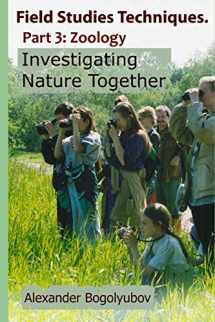
Field Studies Techniques. Part 3. Zoology: Investigating Nature Together
Book details
Summary
Description
This book contains ecological field studies techniques, that can be conducted in wild nature by non-professional researchers - school and university students together with their teachers, single beginning investigators, families, amateurs of all ages.The whole book "Field Studies Techniques" includes 5 parts/series corresponding to a specific field sciences (Geography, Botany, Zoology, Hydrobiology and Bioindication) with totally 40 environmental study lessons (see below) covered a wide variety of activities in nature which can be arranged in different seasons of the year. Each series contains techniques focusing on practical skills which can be applied in the field research.This book promotes a wide variety of outcomes which correspond to established educational standards in many countries. The ecological field study activities address content standards in the areas of earth science, life science, biology and ecology. Intellectual skill development includes questioning, data collection, analysis and drawing conclusions.This book is addressed to the middle and secondary level science teachers and students, and for all those who would like to investigate local wild nature, to share ecological and cultural information and work together to help create a better environment.This specific book "Field Studies Techniques. Part 3: Zoology" is the third in the series. Practical skills include the study of the invertebrates, living in the forest litter, wood, grass, tree crowns and air, as well as water invertebrates (macrozoobenthos). Also the methods of species composition, abundance and behavior of amphibians, birds and mammals are described.The techniques described in this book, were written by Alexander Bogolyubov (1996-2002), translated into English by Tatiana Tatarinova (2002) and edited by Michael Brody (2003).The list of all field study lessons:I. Geography & Landscape Sciences (this book):Orienteering in the forestSimple “Eye” Survey of the Field Study SiteMapping Forest VegetationProcedure of the Geological Exposure DescriptionStudying Minerals and Rocks in Your AreaPlotting a Profile of a River Valley SlopeSimple Procedure of Soil DescriptionIntegrated Study Based on Landscape ProfileStudy of Snow Cover ProfileMaking a CampfireII. Botany:Study of Species Composition and Number of FungiMaking a HerbariumThe Study of Plants in Your Local EnvironmentStudy of the Vertical Structure of a ForestMapping Forest VegetationGreen Plants Under SnowStudy of the Ecology of Early Flowering PlantsPhenology of Plant FlorescenceStudy of Growth Dynamics of Trees Based on Annual RingsIII. Zoology (this book):Study of Forest Invertebrates in the Forest Litter and WoodStudy of Forest Invertebrates in the Grass Layer, Tree Crowns and AirStudies of Species Composition and Abundance of AmphibiansMaking Feeders and Nesting BoxesStudy of Species Composition and Census of Birds Using the Line Transect-counting MethodStudies of Bird Populations Size by Different MethodsStudies of the Day Activity of Singing BirdsStudy of Birds’ Nesting LifeMethods of Observation of a Chickadee Flock's Territorial BehaviorProcedure of Winter Mammals Route Census by FootprintsStudy of Mammal Ecology According to Their TracksIV. Hydrobiology:Complex Comparative Description of Small Rivers and StreamsPhysical and Chemical Properties of Natural WatersThe Study of Water Invertebrates in a Local River and Assessment of Its Environmental StateStudy of PlanktonStudy of Fauna of Spring Temporary Water BodiesV. BioindicationAssessment of Air Pollution by Lichen Indication MethodAssessment of the Vital State of a Forest Based on Pine-tree AnalysisAssessment of Ecological Features of Meadows on the Base of Vegetation CoverAssessment of Environmental State of the Forest Based on Leaves’ AsymmetryAssessment of the Vital State of Coniferous Underbrush


We would LOVE it if you could help us and other readers by reviewing the book
Book review



